Global Pacemakers Market, By Type, By Technology, By Application, By End User, By Region & Segmental Insights Trends and Forecast, 2024 – 2034
- Industry: Healthcare
- Report ID: TNR-110-1228
- Number of Pages: 420
- Table/Charts : Yes
- July, 2024
- Base Year : 2024
- No. of Companies : 10+
- No. of Countries : 29
- Views : 10102
- Covid Impact Covered: Yes
- War Impact Covered: Yes
- Formats : PDF, Excel, PPT
A pacemaker is a small medical device used to help regulate the heartbeat. It’s typically used for people whose hearts beat too slowly (bradycardia) or irregularly. The device sends electrical impulses to the heart to ensure it maintains a proper rhythm and rate. Pacemakers are usually implanted under the skin near the collarbone and connected to the heart via one or more leads (wires). These leads carry electrical signals from the device to the heart muscle. The device can be programmed to adjust the heart’s pace based on the body’s needs.
The global pacemaker market is experiencing robust growth, driven by increasing incidences of cardiovascular diseases and the aging population. Technological advancements in pacemaker devices, such as leadless and MRI-compatible pacemakers, are significant growth drivers. Trends indicate a rising preference for minimally invasive procedures, which enhance patient outcomes and reduce recovery times.
Opportunities abound in emerging markets due to improving healthcare infrastructure and increasing healthcare expenditure. Strategic collaborations and product innovations are fostering market expansion. The integration of artificial intelligence and remote monitoring capabilities in pacemakers is anticipated to further propel market growth, offering enhanced patient management and real-time health data analysis, ultimately improving the quality of care for cardiac patients. In Terms of Revenue, the Global Pacemakers Market was Worth US$ 5.3 Bn in 2023, Anticipated to Witness CAGR of 4.2% During 2024 – 2034.

Opportunities in the Global Pacemakers Market
- Emerging Markets Expansion: Countries in Asia-Pacific, Latin America, and Africa are experiencing rapid economic growth and improvements in healthcare infrastructure. With increasing healthcare expenditures and a growing middle-class population, the demand for advanced medical devices, including pacemakers, is rising. The prevalence of cardiovascular diseases is increasing due to urbanization, lifestyle changes, and aging populations in these regions. Companies investing in localized production, strategic partnerships with local healthcare providers, and tailored marketing strategies can capitalize on this burgeoning demand. For instance, in January 2021, Boston Scientific Corporation acquired Preventive Solutions, a development company specializing in remote cardiac monitoring. Government initiatives to enhance healthcare access and the adoption of innovative technologies further underscore the potential for substantial market growth in these emerging economies.
- Technological Advancements and Innovation: The development of next-generation pacemakers, such as leadless pacemakers, MRI-compatible devices, and those with remote monitoring capabilities, is transforming patient care. These innovations offer significant benefits, including reduced infection risks, improved device longevity, and enhanced patient comfort. The integration of artificial intelligence and machine learning for real-time data analysis and predictive healthcare management is another promising avenue. Companies that invest in R&D to advance these technologies can gain a competitive edge. Collaborations with tech firms and healthcare providers to develop and implement these cutting-edge solutions are expected to drive market growth and improve patient outcomes.
Implantable pacemakers by type category have emerged as a dominant segment in the global pacemakers market due to their advanced technology and superior patient outcomes. These devices offer significant benefits, including continuous heart rate monitoring and automatic adjustments to heart rhythms, enhancing patient quality of life. Technological innovations, such as MRI-compatible and leadless pacemakers, have further boosted their adoption. Additionally, the rising prevalence of cardiovascular diseases and the aging population have increased demand. The minimally invasive nature of implantable pacemakers reduces infection risks and shortens recovery times, making them a preferred choice among healthcare providers. Strategic partnerships and ongoing research and development efforts are expected to continue driving growth in this segment.
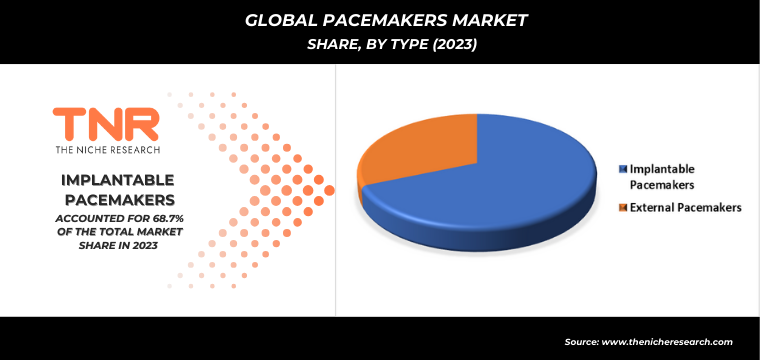
In 2023, MRI-compatible pacemakers segment solidified its position as the second-largest technology category within the global pacemakers market. This growth is attributed to the increasing demand for devices that allow patients to safely undergo MRI scans without compromising pacemaker functionality. Advancements in technology have addressed previous safety concerns, leading to wider adoption among healthcare providers. The rising prevalence of cardiovascular diseases and the need for comprehensive diagnostic imaging have further driven the demand for MRI-compatible pacemakers. Enhanced patient safety, improved diagnostic accuracy, and growing awareness are key factors contributing to the segment’s robust market position.
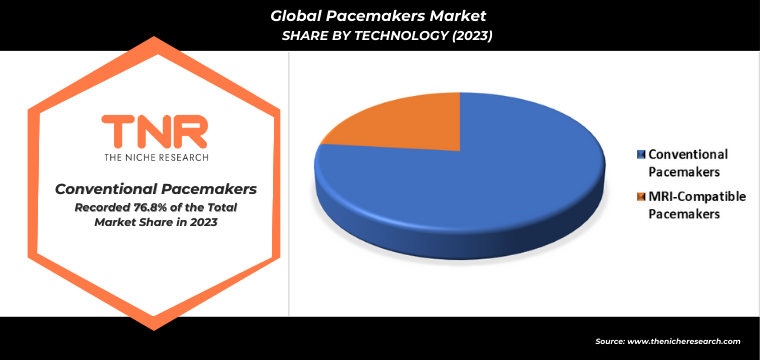
Arrhythmias segment, categorized by application, has exerted significant dominance over the global pacemakers market. This is largely due to the increasing prevalence of cardiac arrhythmias, such as atrial fibrillation and bradycardia, which necessitate effective management and treatment options. Pacemakers play a crucial role in regulating heart rhythms and preventing complications associated with arrhythmias, making them indispensable in cardiac care. Technological advancements in pacemaker devices, including improved battery life and enhanced functionality, have further strengthened this segment. Additionally, rising awareness and early diagnosis of arrhythmias, along with a growing aging population prone to cardiac disorders, have fueled market demand. Consequently, the arrhythmias segment continues to drive significant growth within the global pacemakers market.
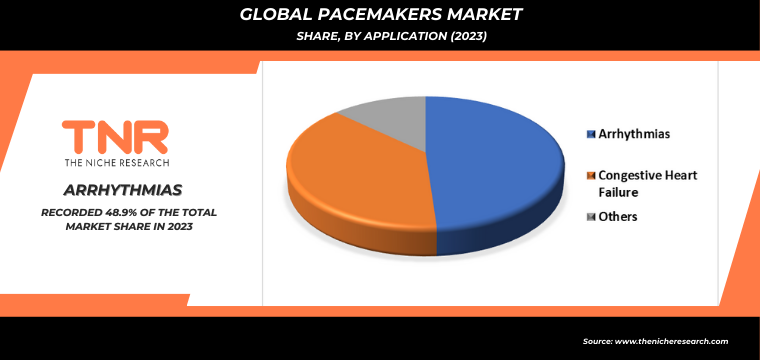
By end user, ambulatory surgical centers segment is anticipated to grow fastest over the forecast timeline in global pacemakers market. This rapid growth is driven by the increasing preference for minimally invasive procedures and the rising number of outpatient cardiac interventions. ASCs offer cost-effective, efficient care with shorter recovery times compared to traditional hospital settings, making them an attractive option for both patients and healthcare providers. Advances in pacemaker technology that support outpatient procedures and the expansion of ASC facilities are further propelling this segment’s growth, reflecting a shift towards more accessible and streamlined cardiac care solutions.
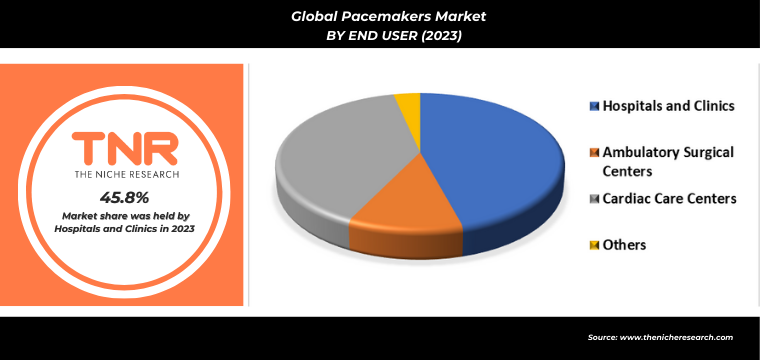
In 2023, North America solidified its dominance in the global pacemakers market, contributing a revenue share of 32.1%. This strong performance is attributed to several factors, including the region’s advanced healthcare infrastructure, high rates of cardiovascular diseases, and robust adoption of innovative pacemaker technologies. The presence of leading medical device manufacturers and significant investments in research and development have further reinforced North America’s market position. Favorable reimbursement policies and a growing emphasis on personalized medicine contribute to the region’s market leadership. North America’s extensive healthcare network and increasing patient awareness continue to drive demand for pacemakers, sustaining its pivotal role in the global market.
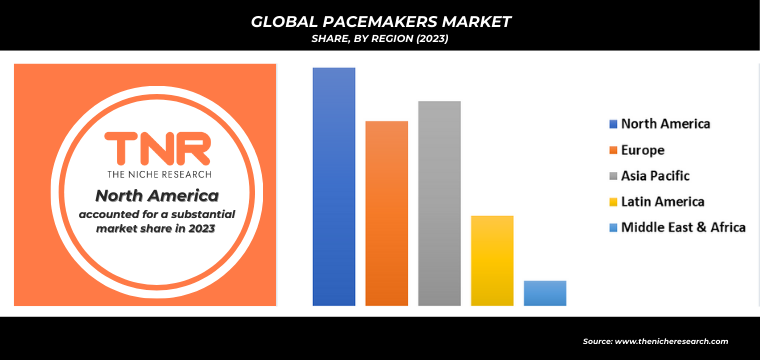
Competitive Landscape
Some of the players operating in the pacemakers market are
- Abbott
- BIOTRONIK SE & Co. KG
- Boston Scientific Corporation
- Lepu Medical Technology (Beijing)Co., Ltd.
- MEDICO S.R.L.
- Medtronic
- MicroPort Scientific Corporation
- OSCOR Inc
- OSYPKA MEDICAL
- Shree Pacetronix Ltd.
- Zoll Medical Corporation, an Asahi Kasei Group Company
- Other Industry Participants
Global Pacemakers Market Scope
| Report Specifications | Details |
| Market Revenue in 2023 | US$ 5.3 Bn |
| Market Size Forecast by 2034 | US$ 8.4 Bn |
| Growth Rate (CAGR) | 4.2% |
| Historic Data | 2016 – 2022 |
| Base Year for Estimation | 2023 |
| Forecast Period | 2024 – 2034 |
| Report Inclusions | Market Size & Estimates, Market Dynamics, Competitive Scenario, Trends, Growth Factors, Market Determinants, Key Investment Segmentation, Product/Service/Solutions Benchmarking |
| Segments Covered | By Type, By Technology, By Application, By End User, By Region |
| Regions Covered | North America, Europe, Asia Pacific, Middle East & Africa, Latin America |
| Countries Covered | U.S., Canada, Mexico, Rest of North America, France, The UK, Spain, Germany, Italy, Nordic Countries (Denmark, Finland, Iceland, Sweden, Norway), Benelux Union (Belgium, The Netherlands, Luxembourg), Rest of Europe, China, Japan, India, New Zealand, Australia, South Korea, Southeast Asia (Indonesia, Thailand, Malaysia, Singapore, Rest of Southeast Asia), Rest of Asia Pacific, Saudi Arabia, UAE, Egypt, Kuwait, South Africa, Rest of Middle East & Africa, Brazil, Argentina, Rest of Latin America |
| Key Players | Abbott, BIOTRONIK SE & Co. KG, Boston Scientific Corporation, Lepu Medical Technology (Beijing)Co., Ltd., MEDICO S.R.L., Medtronic, MicroPort Scientific Corporation, OSCOR Inc, OSYPKA MEDICAL, Shree Pacetronix Ltd., Zoll Medical Corporation, an Asahi Kasei Group Company |
| Customization Scope | Customization allows for the inclusion/modification of content pertaining to geographical regions, countries, and specific market segments. |
| Pricing & Procurement Options | Explore purchase options tailored to your specific research requirements |
| Contact Details | Consult With Our Expert
Japan (Toll-Free): +81 663-386-8111 South Korea (Toll-Free): +82-808- 703-126 Saudi Arabia (Toll-Free): +966 800-850-1643 United Kingdom: +44 753-710-5080 United States: +1 302-232-5106 E-mail: askanexpert@thenicheresearch.com
|
Global Pacemakers Market
By Type
- Implantable Pacemakers
- Single-Chamber Pacemakers
- Dual-Chamber Pacemakers
- Biventricular Pacemakers
- External Pacemakers
By Technology
- Conventional Pacemakers
- MRI-Compatible Pacemakers
By Application
- Arrhythmias
- Heart Block
- Atrial Fibrillation
- Long QT Syndrome
- Congestive Heart Failure
- Others
By End User
- Hospitals and Clinics
- Ambulatory Surgical Centers
- Cardiac Care Centers
- Others
By Region
- North America (U.S., Canada, Mexico, Rest of North America)
- Europe (France, The UK, Spain, Germany, Italy, Nordic Countries (Denmark, Finland, Iceland, Sweden, Norway), Benelux Union (Belgium, The Netherlands, Luxembourg), Rest of Europe)
- Asia Pacific (China, Japan, India, New Zealand, Australia, South Korea, Southeast Asia (Indonesia, Thailand, Malaysia, Singapore, Rest of Southeast Asia), Rest of Asia Pacific)
- Middle East & Africa (Saudi Arabia, UAE, Egypt, Kuwait, South Africa, Rest of Middle East & Africa)
- Latin America (Brazil, Argentina, Rest of Latin America)
Report Layout:
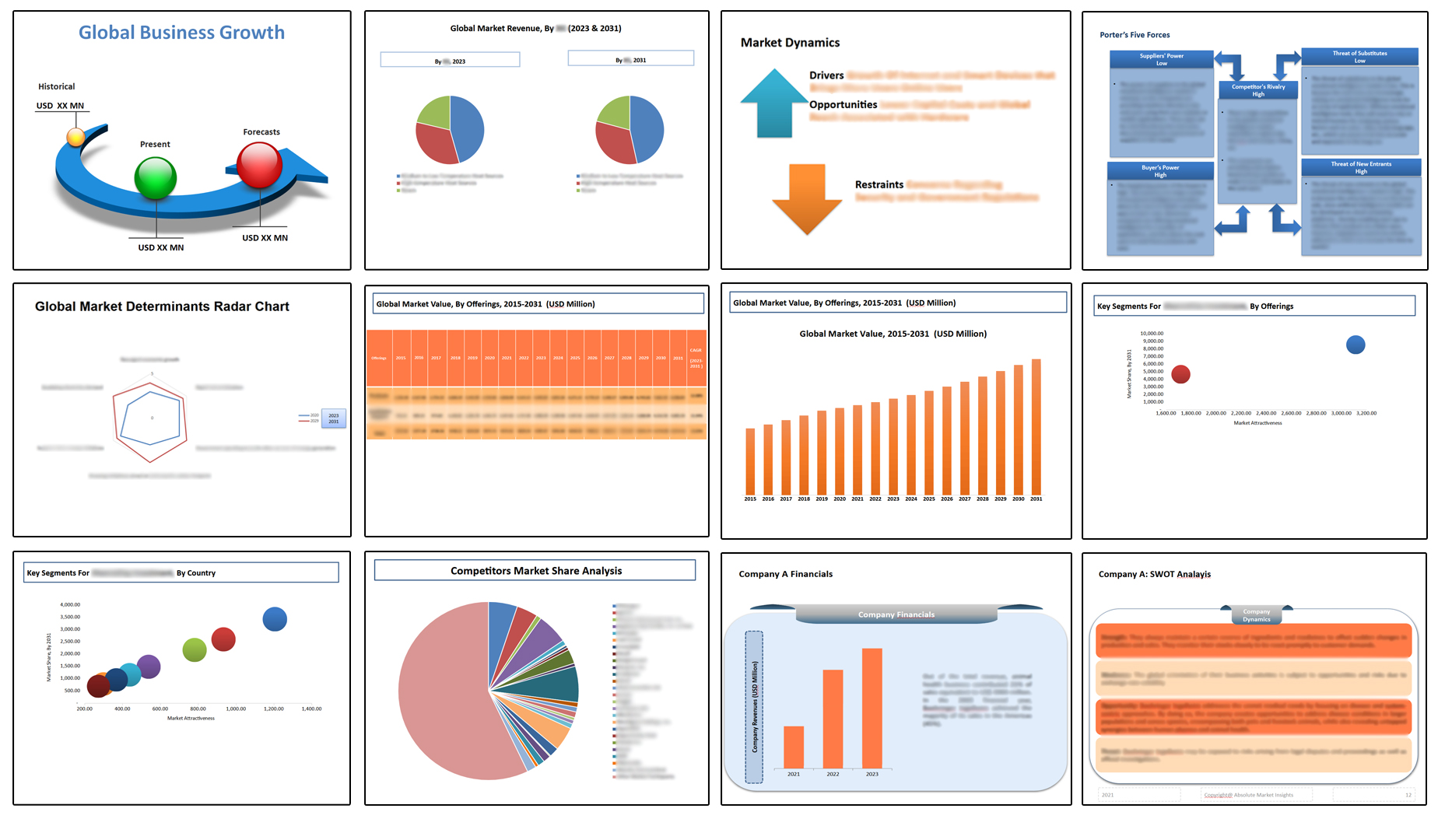
Table of Contents
Note: This ToC is tentative and can be changed according to the research study conducted during the course of report completion.
**Exclusive for Multi-User and Enterprise User.
Global Pacemakers Market
By Type
- Implantable Pacemakers
- Single-Chamber Pacemakers
- Dual-Chamber Pacemakers
- Biventricular Pacemakers
- External Pacemakers
By Technology
- Conventional Pacemakers
- MRI-Compatible Pacemakers
By Application
- Arrhythmias
- Heart Block
- Atrial Fibrillation
- Long QT Syndrome
- Congestive Heart Failure
- Others
By End User
- Hospitals and Clinics
- Ambulatory Surgical Centers
- Cardiac Care Centers
- Others
By Region
- North America (U.S., Canada, Mexico, Rest of North America)
- Europe (France, The UK, Spain, Germany, Italy, Nordic Countries (Denmark, Finland, Iceland, Sweden, Norway), Benelux Union (Belgium, The Netherlands, Luxembourg), Rest of Europe)
- Asia Pacific (China, Japan, India, New Zealand, Australia, South Korea, Southeast Asia (Indonesia, Thailand, Malaysia, Singapore, Rest of Southeast Asia), Rest of Asia Pacific)
- Middle East & Africa (Saudi Arabia, UAE, Egypt, Kuwait, South Africa, Rest of Middle East & Africa)
- Latin America (Brazil, Argentina, Rest of Latin America)
The Niche Research approach encompasses both primary and secondary research methods to provide comprehensive insights. While primary research is the cornerstone of our studies, we also incorporate secondary research sources such as company annual reports, premium industry databases, press releases, industry journals, and white papers.
Within our primary research, we actively engage with various industry stakeholders, conducting paid interviews and surveys. Our meticulous analysis extends to every market participant in major countries, allowing us to thoroughly examine their portfolios, calculate market shares, and segment revenues.
Our data collection primarily focuses on individual countries within our research scope, enabling us to estimate regional market sizes. Typically, we employ a bottom-up approach, meticulously tracking trends in different countries. We analyze growth drivers, constraints, technological innovations, and opportunities for each country, ultimately arriving at regional figures.Our process begins by examining the growth prospects of each country. Building upon these insights, we project growth and trends for the entire region. Finally, we utilize our proprietary model to refine estimations and forecasts.
Our data validation standards are integral to ensuring the reliability and accuracy of our research findings. Here’s a breakdown of our data validation processes and the stakeholders we engage with during our primary research:
- Supply Side Analysis: We initiate a supply side analysis by directly contacting market participants, through telephonic interviews and questionnaires containing both open-ended and close-ended questions. We gather information on their portfolios, segment revenues, developments, and growth strategies.
- Demand Side Analysis: To gain insights into adoption trends and consumer preferences, we reach out to target customers and users (non-vendors). This information forms a vital part of the qualitative analysis section of our reports, covering market dynamics, adoption trends, consumer behavior, spending patterns, and other related aspects.
- Consultant Insights: We tap into the expertise of our partner consultants from around the world to obtain their unique viewpoints and perspectives. Their insights contribute to a well-rounded understanding of the markets under investigation.
- In-House Validation: To ensure data accuracy and reliability, we conduct cross-validation of data points and information through our in-house team of consultants and utilize advanced data modeling tools for thorough verification.
The forecasts we provide are based on a comprehensive assessment of various factors, including:
- Market Trends and Past Performance (Last Five Years): We accurately analyze market trends and performance data from preceding five years to identify historical patterns and understand the market’s evolution.
- Historical Performance and Growth of Market Participants: We assess the historical performance and growth trajectories of key market participants. This analysis provides insights into the competitive landscape and individual company strategies.
- Market Determinants Impact Analysis (Next Eight Years): We conduct a rigorous analysis of the factors that are projected to influence the market over the next eight years. This includes assessing both internal and external determinants that can shape market dynamics.
- Drivers and Challenges for the Forecast Period:Identify the factors expected to drive market growth during the forecast period, as well as the challenges that the industry may face. This analysis aids in deriving an accurate growth rate projection.
- New Acquisitions, Collaborations, or Partnerships: We keep a close watch on any new acquisitions, collaborations, or partnerships within the industry. These developments can have a significant impact on market dynamics and competitiveness.
- Macro and Micro Factors Analysis:A thorough examination of both macro-level factors (e.g., economic trends, regulatory changes) and micro-level factors (e.g., technological advancements, consumer preferences) that may influence the market during the forecast period.
- End-User Sentiment Analysis: To understand the market from the end-user perspective, we conduct sentiment analysis. This involves assessing the sentiment, preferences, and feedback of the end-users, which can provide valuable insights into market trends.
- Perspective of Primary Participants: Insights gathered directly from primary research participants play a crucial role in shaping our forecasts. Their perspectives and experiences provide valuable qualitative data.
- Year-on-Year Growth Trend: We utilize a year-on-year growth trend based on historical market growth and expected future trends. This helps in formulating our growth projections, aligning them with the market’s historical performance.
Research process adopted by TNR involves multiple stages, including data collection, validation, quality checks, and presentation. It’s crucial that the data and information we provide add value to your existing market understanding and expertise. We have also established partnerships with business consulting, research, and survey organizations across regions and globally to collaborate on regional analysis and data validation, ensuring the highest level of accuracy and reliability in our reports.









